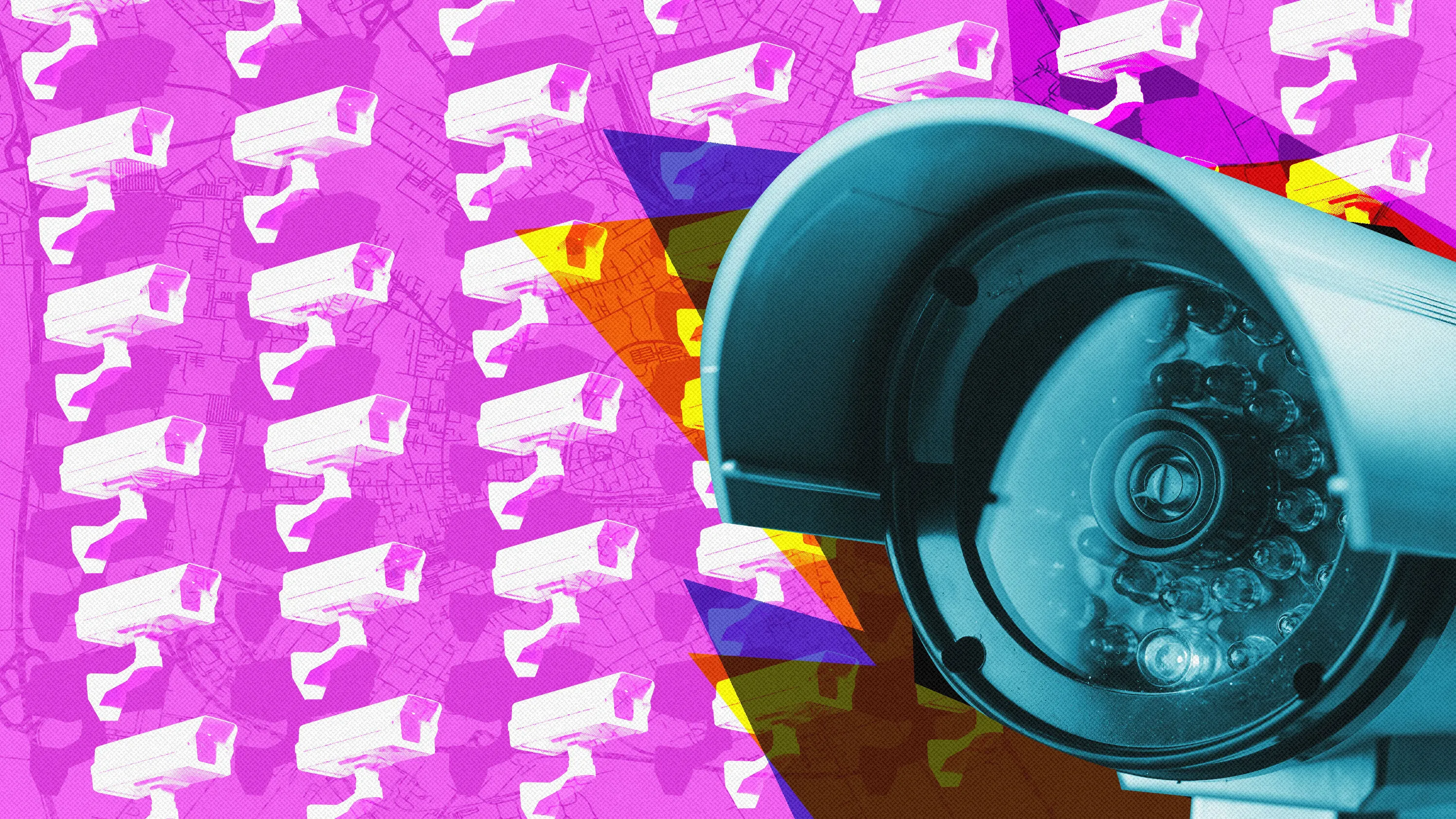Copyright wired

These devices are distributed throughout 16,460 Video Surveillance Technology Systems (VTS)’s, which make up a total of 48,156 installed cameras. Also known as “C5 poles,” each of these systems can incorporate up to five lenses and a camera with a maximum resolution of up to 4K, which allows for a 360-degree view. In addition to the VTS’s, there are 17,629 camera-equipped poles. Each one has two cameras installed, an emergency button, and a turret to issue visual and audible alerts in an emergency. This video surveillance system helps to offer traffic alternatives, to follow up demonstrations or road accidents, and to track robbery suspects in real time. It is a fundamental piece in the security plan promoted by city authorities. At the end of August, the government of Mexico City announced the purchase of more than 30,000 new video cameras to be installed throughout the city in order to strengthen the video surveillance strategy, as the recordings are a key tool of the Prosecutor’s Office to identify and prosecute suspects and better ensure guilty verdicts in court. “What is recommended is that when something happens, they go to open the folder and the next day request the video evidence, because [without an investigation file] they will not be able to access this information,” says Salvador Guerrero Chiprés, general coordinator of C5 CDMX. In fact, he shared that they receive around 160 requests per day from people asking for the C5 recordings to present as evidence in court. In other words, if an average of 640 investigation files are opened every day in Mexico City (232,476 per year, according to data from the 2024 National Census of State and Federal Prosecution of Justice), 25 percent of these have a recording from government cameras as evidence. Although Mexico City’s video surveillance system is a tool to prevent and punish crimes, the city still registers the highest crime rate in the country, with 54,473 crimes per 100,000 inhabitants. In a survey conducted in 2025 by the National Institute of Statistics and Geography, 75.6 percent of residents said they did not feel secure. “The inhibition and prosecution of crime are complementary … All the world literature indicates it, all the data from all the public security secretariats around the world indicate it, and in the case of Mexico City, it is also obvious that there is more citizen confidence when there are more cameras, whether public or private,” Guerrero Chiprés says. Despite the fact that the country’s capital is the most heavily monitored city in the continent, there is still a lot of territory to cover. Data shared by the head of C5 reveals that only a third of the city is covered by these cameras. “Nowhere in the world does it happen [that there is surveillance in 100 percent of public spaces],” Guerrero Chiprés says. “That is why there must be contribution from the whole community. If the community does not participate with its own cameras and also with its civic view, [security] is impossible, because there are more than 63,000 blocks in the city, and we have a presence in 20,000.” Enter the Spy Bunker Strategically located in the busiest areas with the highest crime rates, the video surveillance cameras operate from Mexico City’s Command, Control, Computing, Communications, and Citizen Contact Center (C5 CDMX), a bunker that works 24/7, and where there is a permanent presence of representatives from 29 federal and local agencies, such as Mexico’s National Guard, the Navy, the Defense, and the Secretariats of Citizen Security. Although C5 is primarily known for video surveillance, this space brings together different ways to follow up on complaints from residents. There's a 911 line for dispatching ambulances, patrol cars, and firefighters; 089, a line to anonymously report a crime; *765, a line specifically for gender violence; and *0311 (or Locatel) to make reports or service requests. The H2O water line (*426) is also operated from C5, to report leaks or lack of water supply. As part of the modernization and strengthening of the video surveillance system, Mexico City is in the process of replacing older equipment and obsolete technology dating back to 2009, when the Emergency Attention and Citizen Protection Center of Mexico City was created. At that time, the first 8,000 cameras were installed. By 2018, they had barely reached 15,000 cameras; in 2019, they reached 43,000; by 2022, they surpassed 49,000, and now, in 2025, there are 83,414 devices. Currently, the 83,414 video cameras in operation (and the more than 30,000 that are in the process of being installed) have different technologies. Some cannot be rotated, others have no zoom capability, and still others have poor recording quality. Even the memory of each device varies. There are cameras that are able to keep recordings for seven days, others for 14 days, and the most recent ones have the ability to keep videos for 30 days. 150,000 Cameras by 2030 In order to reinforce the security strategy in Mexico City, the local government allocated 345 million pesos ($18.5 million) to purchase 30,400 new surveillance cameras as part of the “Eyes that take care of you” program. Once their installation is complete, there will be 113,000 video surveillance cameras, which will keep Mexico City as the most video-surveilled city in America, with almost twice as many public video cameras as New York, and three times as many as Chicago and Rio de Janeiro. The new devices are of the latest technology and will be placed in pairs on the C5 posts: one fixed camera and another with the ability to pan, tilt up and down, zoom in, and zoom out. They also have night vision, people and vehicle detection, resistance to extreme conditions, and an anti-vandalism system. In addition, they have an internal alert system that warns of operational failures, which speeds up the attention to the devices in case of failures or damage due to use, factory problems, weather conditions, and even birds that nest on the video surveillance posts. On average, Guerrero Chiprés reported, 98 percent of all video surveillance cameras operate correctly on a daily basis. In 2024, according to the response to a public information request, the C5 allocated 354 million pesos for preventive and corrective maintenance of all video cameras. By 2030, at the end of Clara Brugada’s administration as head of government, it is projected that throughout Mexico City there will be 150,000 government video cameras installed in public spaces with a high concentration of people, as well as in neighborhoods and areas with high crime rates. “We have six generations of cameras, and the oldest ones are already 14 years old, so they are approaching their definitive obsolescence,” said the head of the C5 CDMX. “Based on what the operators report to us, what the citizens tell us, and what the companies that also carry out the supervision and maintenance tell us, we are renewing and replacing the corresponding cameras.” Hit That Share Button In her book La Ciudad Videovigilada, Carmina Jasso López explains that terrorist attacks in different cities around the world triggered an increase in public investment for the installation of video surveillance cameras. In 1993, after terrorist attacks by the Irish Republican Army, there was a boom in the installation of cameras in London. No one knows exactly how many video cameras there are (estimates range from 600,000 to 900,000), as more than half of the devices are installed by private individuals—a model that Mexico City authorities are taking inspiration from. In London, the academic explains, there is one surveillance camera for every 14 inhabitants, which opens the possibility that a person in the city could be filmed 300 times a day. The government of Mexico City is not looking for private surveillance cameras, those that citizens install outside their homes or businesses, to be connected to C5, but rather for residents to be open to sharing videos with authorities if they may be helpful to an investigation. “We recommend that all private persons buy cameras, that all businesses have cameras—if possible, that they acquire cameras technologically compatible with those of the C5—to expand the video surveillance network, and that this task is not only of the central government, but can also be of the entire community, as happens in some cities in Europe such as London,” Guerrero Chiprés says. The installation of private cameras, however, also entails an undesirable possibility. In Mexico, all levels of government work daily to dismantle private recording equipment that is placed on public infrastructure such as poles or traffic lights, and which is used by criminal groups to monitor and react in real time to operations by public security forces. Reaching the Limit In her book, Carmina Jasso López also points out the importance of regulating both public and private video surveillance to protect the human rights of people, which could be violated by constant monitoring. According to Jasso López, there are three rights that could be violated if governments do not work and promote a regulatory framework: the right not to be discriminated against, the right to personal data protection, and the right to privacy. Research shows that “camera operators use a series of highly stereotyped and questionable markers related to a citizen’s age, race, clothing, and behavior to identify people who deserve special attention,” she adds. Questioned on the matter, Salvador Guerrero Chiprés affirmed that the ethical limits in the operation of video surveillance cameras are bound by the Federal Law for the Protection of Personal Data in Possession of Individuals (and by extension, in possession of institutions), as well as by all laws and regulations related to public security. According to the research conducted by Jasso López, although Mexico does not have a national legal framework on video surveillance, different cities around the world have already made significant progress in regulating these and other ethical dilemmas. For example, she points to “the Charter for the Democratic Use of Video Surveillance developed by the European Forum for Urban Security, in which more than 10 European countries participate with the aim of ‘reconciling the use of video surveillance and individual freedoms.’” This story originally appeared in WIRED en Español and has been translated from Spanish.



